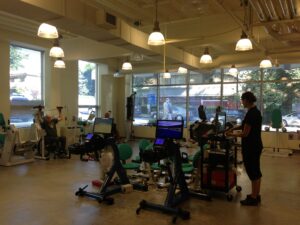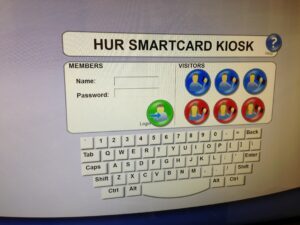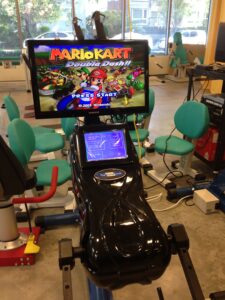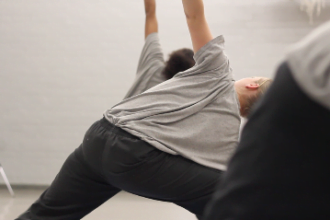
Machines can be used by able-bodied and disabled athletes
A few weeks ago, I had the opportunity to visit the PARC facility at the ICORD Spinal Cord Research Centre in Vancouver, BC with our guest blogger Lynda Bennett. Lynda is participating in an exercise study for people with spinal cord injuries and she wanted to show me around. The study is in pilot stage right now and has less than 50 participants all of whom have spinal cord injuries. Lynda doesn’t actually have an injury, she was born with Spina Bifida. However, she has recently started using an electric chair and is concerned about keeping up her core and upper body strength, especially for transfers from the chair. The pilot study is looking for positive outcomes associated with regular and increasing levels of exercise in people with spinal cord injury.
The equipment at the facility looks like that at any gym, however there are two key differences. Each machine is adapted so that a person can access it from a wheelchair. Actually the machines are designed both for able-bodied and disabled users and ICORD employees are allowed to use the gym if the study isn’t actively using it. If a machine has a seat, which an able-bodied person might use, it swings away to enable someone to wheel up to it. The other difference is that each machine is fitted with a smart card reader. Study participants enter their cards to start the weight program. The machines use air-pressure to provide resistance, and the resistance is increased automatically based on previous day’s activities. All the data is collected and can be reviewed by researchers. You can think of it as ‘quantified-self’ but with extremely expensive quantification.
While Lynda enjoyed her workouts and meeting with others at the facility, she would have liked to have seen active rather than passive goal setting. She wanted the goals to be translated into something that she needed to do in everyday life. “to be able to transfer from your chair to a truck, you’ll need X amount of core body strength.” As the study is designed, she is increasing the amount of weight but doesn’t know what outcomes this will provide in her daily life.
“I’d like to see how I am progressing towards a goal rather than try to correlate the increased weights to some improvement myself.”
Since this is just a pilot, and they are trying to keep the research relatively open to start, this might be able to be designed into future research.
Unfortunately, the pilot study isn’t guaranteed to go to a large scale study. The initial funding was used to set up the facility, and additional funding will be required to expand beyond the pilot. However, pilot organizers are hoping once they get enough data and can start to form hypotheses, they will attract the interest of the many researchers in the labs upstairs at ICORD, who are working with cells and microscopes but not as often with real human subjects like the people who volunteered for this study. Facilities like PARC and the data they collect can go a long way to bridge the gap between research and human outcomes.










